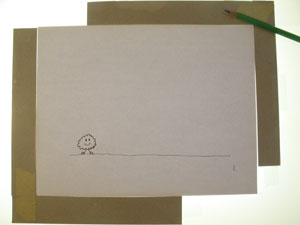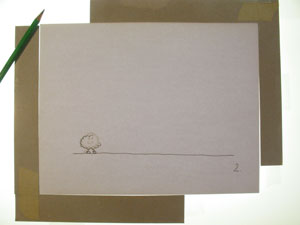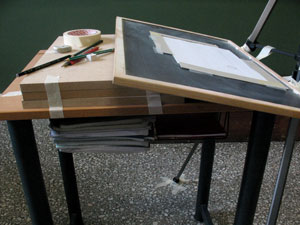






- White sheets of paper (80 gr). The size should be in proportion with the dimensions of the photographs of your camera.
A common size for digital cameras is the 4:3 ratio.
Try using A4 size paper and cutting off a strip on one side, making the dimensions 21 x 27cm.
- Pencil, sharpener, eraser
- Black fine-point marker or marker pen
- 4 pieces of cardboards (approx.) 3 x 15
- Adhesive tape
- Digital photo camera
- Tripod
- Computer with installed video editing software
- Lighting - table or floor lamp (not necessary)




- To produce a moving image film using sketches and drawings you will have to make very many drawings… so, pluck up your patience!!!
- Remember the booklets with images that look like they are moving when you flip through the pages with your thumb? The drawings in these booklets are slightly different from one page to the next. These booklets are called: Flip books
Your drawings will be like the ones in a flip book, except you’ll be working on larger sheets of paper. - Crop A4 size sheets of paper to 21 x 27 cm (if you have desided on
the 4:3 ratio)
Start with 20 sheets and crop more if you need them later. - Decide on what you want to draw and how you want it to move.
Start with something simple. It’s a good idea to make a few rough drawings before starting on separate sheets of paper. -
Make your first drawing on a sheet of paper and mark a number 1 at the top right corner
Place your second sheet of paper precisely on top of the first and mark a number 2 in the same corner. Then, trace your initial drawing while changing it slightly. Change your drawing by moving something or altering certain lines or shapes. You can see what you are doing because the first drawing shows through the second sheet of paper.
Place a third sheet of paper on top of the second, number it 3, and continue to trace your drawing and making your small changes.
Continue with more sheets of paper until your sequence is finished.
Make sure to place each sheet of paper exactly on top of the previous sheet before starting to draw.
Don't forget to number your drawings at the top right corner
At the beginning it it’s easier if you draw with a pencil.
It’s better to use a soft lead pencil, such as B or 2B, which makes darker lines.
Later, (when you like what you have done) you can go over your drawings with a dark color marker.
As soon as you are more experienced, you can draw with whatever
you like: color markers, wax crayons, oil pastels, pencils, fine point pens, etc.



.jpg)


- Tape your first sheet of paper on to the table.
Make two right angles (corners?) using the 4 strips of cardboard (approx 3 x 15 cm)
These two angles (corners?) will be guides for placing your sheets of paper in the exact same place.
Carefully position the guides at two opposite corners of your sheet of paper. Securely tape the guides to the table top. - Mount your camera on to the tripod. Adjust the tripod facing downwards towards your sheet of paper. Look into the camera screen. Make sure you can see the entire sheet of paper with your drawing as straight as possible in the screen.
If the entire drawing is not in the screen you might have to adjust the tripod so that the camera is higher up. If you can see the guides – angles (corners?), then the camera must move closer to the paper.
 Try using the camera zoom to get closer or move away from your sheet of paper.
Try using the camera zoom to get closer or move away from your sheet of paper.
If you can’t avoid seeing the tripod legs in the camera screen, try tilting the surface on which you place your drawings and then tilt your camera by adjusting the tripod. - Spend some time on the lighting. Make sure that no surrounding objects, the tripod or even you cast shadows on your sheet of paper. If you want, you might try lighting the set with a portable lamp on one side (or even better, one lamp on either side). The lamps should cast a smooth flat light on your paper and make sure to avoid shines and shimmers
 Make sure your lighting is constant. All photographs should have the same lighting to make sure that some are not brighter than others.
Make sure your lighting is constant. All photographs should have the same lighting to make sure that some are not brighter than others. - When everything is ready and set up, it’s time to start photographing!
You’ve already read Before Starting, so you know that while photographing your drawings, the camera and the tripod have to be absolutely stable. Watch out! It’s easy to kick the table or tripod by accident..
Photograph the first sheet of paper, your first drawing, which is between the cardboard guides on the table. Remove the first drawing, place the sheet with the second drawing between the guides and take the next photo. Remove the second drawing, place the third sheet of paper and take another photo… Keep going until there are no more drawings left.
 It is much easier and fun to work with friends! If there are two of you, one can place and remove the papers between the guides and the other can take the photos.
It is much easier and fun to work with friends! If there are two of you, one can place and remove the papers between the guides and the other can take the photos.
When you have finished photographing your entire sequence, remove the camera from the tripod. Transfer the photos into a folder in your computer.
 It is a good idea to name your project folder with a name which reminds you of the sequence you have just photographed e.g. jumping sponge.
It is a good idea to name your project folder with a name which reminds you of the sequence you have just photographed e.g. jumping sponge.
Your drawings seem to move when you view the photos you took very quickly one after the other.
For this you will need to use video editing software. Many computers have this software already installed and, if not, include a program that can be downloaded from the internet. Read about how to edit your file in the Before Starting chapter.
 Making moving images with drawings can be also achieved without a camera and tripod. If you have a scanner you can scan your drawings! But remember: each sheet must be placed exactly at the same place as the one before. Use one corner and sides of the scanner bed as guides.
Making moving images with drawings can be also achieved without a camera and tripod. If you have a scanner you can scan your drawings! But remember: each sheet must be placed exactly at the same place as the one before. Use one corner and sides of the scanner bed as guides.

On the left are examples of drawn animation projects created by primary school children in workshops led by Christina dePian.
Bellow, are links to examples of short animation videos on the internet created by children, students and/or amateurs. Further down, are examples of work by professionals and some classics of drawn animation.
Have a look and use these videos as a sourse of inspiration and ideas.
Contact us when you have created your own animation projects.
We are looking forward to seeing them!
Videos created by children, students and amateurs:
- Animation on board - Music School of Tripolis, Greece
- Concert for Pencils - created by further education students
- Pupils animating 2 - One of three videos creted by primary school children in Ag. Nicolao, Crete, Greece
- The drop
- Flower growth
- Drummer
Videos created by professionals:
- I do art
- Dramaspot
- Prisunic Μαρινόπουλος
- Serenata
- First Greek animated feature (1942 - 45)
- British Airways commercial
- What is a friend
- Sometimes everyone needs a hug
- Bicycles for humanity
- Walking in the Air (from The Snowman)
